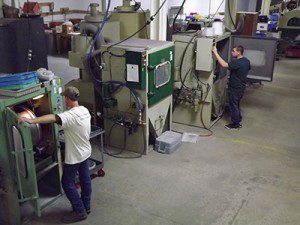Several factors should be considered when choosing the appropriate metal finishing process for your application. Details such as turnaround time, cost, and industry all play a role in deciding which finishing is best for your part. Two of the most common types of metal finishing processes are superfinishing and metal tumbling, the differences of which can often get confused. Although they both work towards the same end goal – polishing and refining surface finish – the processes look very different. So, what is superfinishing and metal tumbling? Let’s break it down.
What is Superfinishing?
Superfinishing, sometimes called micro-finishing, is a finishing process that’s used to refine the surface of a metal component to an extremely fine surface with very low roughness, normally referred to as Ra. This is done using fine-grit abrasives, such as stone, that’s rotated over the part as it’s spun in the opposite direction. The superfinishing process removes the amorphous surface layer, increasing the life of a part by helping decrease wear and tear while achieving better sealing capabilities. This process allows for a repeatable, predictable finish which is isotopic, that is uniform in all directions. After superfinishing, the part is very smooth but not necessarily shiny (polished). The very fine (microscopic) surface lines remaining after superfinishing are completely random: that is uniformly going in all directions.
In the subsequent finishing process, the abrasive material contacts the rough surface of the next part and the above phases are repeated. This process allows you to achieve virtually any surface finish.
What is Tumble Finishing?
Tumble finishing, commonly referred to as mass tumbling, is a finishing process that handles the polishing of multiple small, rough parts at the same time. This process is recommended for manufacturers hoping to achieve uniform smoothness for mass-produced parts. Tumble finishing requires the use of multiple machines, with completion time depending on the specifications for the finished application. Different types of tumble finishing will be recommended depending on the needs of the component, most commonly either high energy tumbling or vibratory tumbling.
High Energy Tumbling
High energy tumbling uses centrifugal force to polish a batch of parts simultaneously and is preferred for many applications due to its fast turn-around time. It’s also ideal for materials including titanium, aluminum, steel, and stainless steel.
This process uses a machine consisting of sealed barrels that are spun to create a force – before it’s turned on, each barrel is filled with water, media, and surfactant in addition to the parts that are to be finished. The spinning carousel pushes the barrels in the opposite direction, creating the centrifugal force that polishes the batch.
Vibratory Tumbling
Vibratory tumbling involves applying force to parts that are placed in a vibratory bowl or tub, usually along with water and abrasive media. As the machine vibrates, the parts move with the media which, in effect, polishes and deburrs them. Vibratory tumbling is widely used for mass finishing applications, from cleaning and descaling to surface preparation and polishing. It’s a tried-and-true finishing method that’s been around since the 1940s due to its effectiveness, gentleness on frail parts, and extremely smooth results.
Contact the Finishing Experts at RP Abrasives
RP Abrasives is proud to serve companies around the country as a leader in metal finishing. Our advanced processes are highly effective in achieving preferred surfaces on parts and, with our wide selection of processes available, we can achieve just about any finish you need. If you have questions about the tumble finishing process, or which type of finishing will be best for your part, contact us today!
